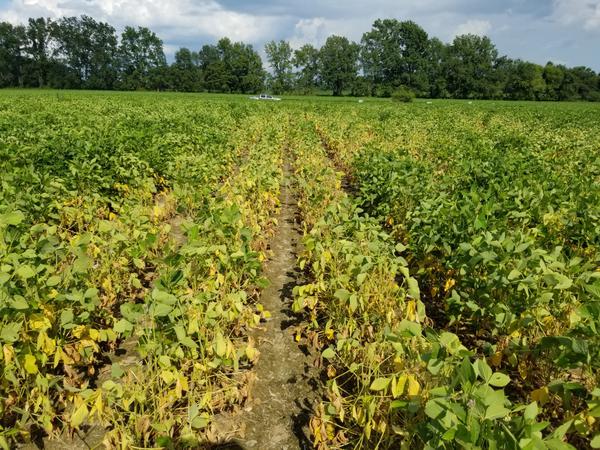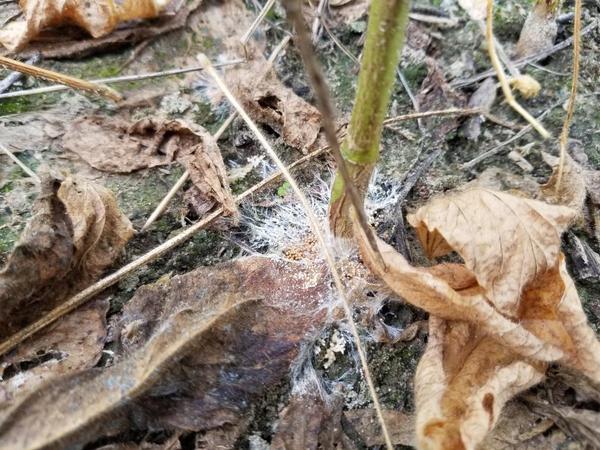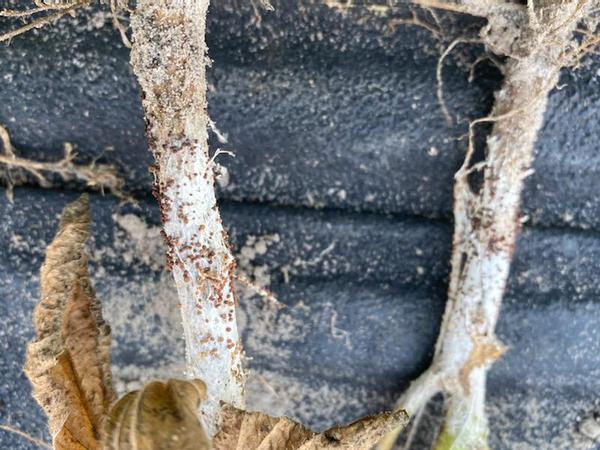Introduction
Southern blight is a common pathogen in the United States, and affects hundreds of host plants. While it is not commonly a problem for soybeans in North Carolina, it can locally cause damages when environmental conditions are conducive for disease. Yield losses are rarely significant for North Carolina soybean producers.
Pathogen
Southern blight of soybean is caused by the fungus Sclerotium rolfsii. This pathogen is common in North Carolina, and can survive in the soil for long periods of time (3 to 4 years) as sclerotia (overwintering structures). When warm, wet conditions are present, sclerotia germinate, and the hyphae invade the host just below or at the soil line.
Host Range
Sclerotium rolfsii has a host range over over 200 plant species, many of which are common rotation crops or weeds, including peanut, tobacco, cucurbits, sweetpotato, ornamental plants, etc.
Symptoms and Signs
Yellowing and wilting are usually the first symptoms observed (Figure 1). Additionally, light brown lesions develop on stems near soil surface and later darken (Figure 2). The fungus rapidly grows from infection sites, usually at the lower stem, and produces a white, fan-like mat of hyphae on infected stems (Figure 2). Numerous tan to brown overwintering structures called sclerotia (Figure 3) are formed in the fungal mat that are about the size of mustard seed are produced as nutrients are depleted.
Disease Cycle and Conditions Favorable for Disease
Soybean plants are more susceptible during early growth stages, but S. rolfsii can affect any stage of soybeans. Sclerotia act as the principle overwintering structures and primary inoculum for disease. This structure can survive in the upper soil and plant debris for several years until conditions are conducive. High temperatures (77-95°F) and moist conditions are associated with germination of sclerotia. High soil moisture, dense planting, and frequent irrigation may all promote infection. Since S. rolfsii does not produce spores, dissemination depends on movement of infested soil and infected plant material. Use of contaminated equipment and machinery may spread sclerotia to uninfected fields. Once sclerotia germinate, hyphae (fungal roots) invade plant roots or lower stems. Once nutrients become depleted, the fungus forms new sclerotia that survive in the soil or crop debris until the next suitable host is available.
Management
Crop rotations to non-host crops like corn, grain sorghum, or wheat, for two or more years can be beneficial to reduce fungal build-up in the soil. Deep cultivation practices that bury sclerotia may also be beneficial to reduce the longevity of the fungus, but may not be available to all farming systems. Fungicides are not recommended for managing Southern blight.
Useful Resources
The NC State University Plant Disease and Insect Clinic provides diagnostics and control recommendations.
The Extension Plant Pathology portal provides information on crop disease management.
The North Carolina Agricultural Chemicals Manual provides pesticide information for common diseases of North Carolina. The manual recommendations do not replace those described on the pesticide label, and the label must be followed.
Acknowledgements
This factsheet was prepared by the NC State University Field Crops and Tobacco Pathology Lab in 2020.
- Check out our Facebook and our Twitter!
Publication date: Sept. 8, 2020
N.C. Cooperative Extension prohibits discrimination and harassment regardless of age, color, disability, family and marital status, gender identity, national origin, political beliefs, race, religion, sex (including pregnancy), sexual orientation and veteran status.
NC Cooperative Extension prohíbe la discriminación por raza, color, nacionalidad, edad, sexo (incluyendo el embarazo), discapacidad, religión, orientación sexual, identidad de género, información genética, afiliación política, y estatus de veteran.
The use of brand names in this publication does not imply endorsement by NC State University or N.C. A&T State University of the products or services named nor discrimination against similar products or services not mentioned.
Recommendations for the use of agricultural chemicals are included in this publication as a convenience to the reader. The use of brand names and any mention or listing of commercial products or services in this publication does not imply endorsement by NC State University or N.C. A&T State University nor discrimination against similar products or services not mentioned. Individuals who use agricultural chemicals are responsible for ensuring that the intended use complies with current regulations and conforms to the product label. Be sure to obtain current information about usage regulations and examine a current product label before applying any chemical. For assistance, contact your local N.C. Cooperative Extension county center.
N.C. Cooperative Extension prohibits discrimination and harassment regardless of age, color, disability, family and marital status, gender identity, national origin, political beliefs, race, religion, sex (including pregnancy), sexual orientation and veteran status.



